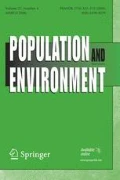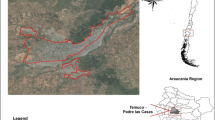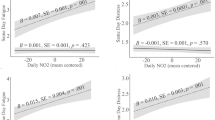Abstract
Exploratory modelling revealed associations of individual perceptions, social factors, and physical components of air pollution with depressive symptomatology. Residents of the Los Angeles Metropolitan Area who have experienced a recent, undesirable life event and who perceive poor air quality in their neighborhood have greater symptoms of depression. These effects control for socioeconomic status and prior psychological status. In addition we show that perceived air quality is a function of both toxic components of ambient air as well as individual psychosocial experiences.
Similar content being viewed by others
References
Aneshensel, C., Frerichs, R. R., Clark, V. A., & Yokopenic, P. A. (1983). Measuring depression in the community: A comparison of telephone and personal interviews.Public Opinion Quarterly, 46 110–121.
Barker, M. (1976). Planning for environmental indices: Observer appraisals of air quality. In K. Craik & E. Zube (Eds.),Perceiving environmental quality (pp. 175–204). NY: Plenum.
Briere, J., Downes, A., & Spensley, J. (1983). Summer in the city: Urban weather conditions and psychiatric-emergency room visits.Journal of Abnormal Psychology, 92 77–80.
Brown, G. W., & Harris, T. (1978).Social origins of depression: A study of psychiatric disorder in women. New York: The Free Press.
Catalano, R., & Dooley, D. (1983). The health effects of economic instability: A test of the economic stress hypothesis.Journal of Health and Social Behavior, 24 46–60.
Cohen, S. (1980). Aftereffects of stress on human performance and social behavior: A review of research and theory.Psychological Bulletin, 88 82–108.
Cohen, S., Evans, G. W., Stokols, D., & Krantz, D. S. (in press).Behavior, health, and environmental stress. New York: Plenum.
Craik, K., & Zube, E. (1976).Perceiving environmental quality. New York: Plenum.
Dohrenwend, B. P., & Dohrenwend, B. S. (1982). Perspectives on the past and future of psychiatric epidemiology: The 1981 Rema Lapouse Lecture.American Journal of Public Health, 72 1271–1279.
Dohrenwend, B. S., Krasnoff, L., Askensay, S., & Lohrenwend, B. P. (1978). Exemplification of a method for scaling life events: The PERI life events scale.Journal of Health and Social Behavior, 19 205–229.
Dohrenwend, B. P., Oskenberg, L., Shrout, P., Dohrenwend, B. S., & Cook, D. (1981). What brief psychiatric screening scales measure. In S. Sudman (Ed.),Health survey research methods: Third biennial conference (188–198). Washington, DC: National Center for Health Services Research.
Dooley, D., & Catalano, R. (1984). Why the economy predicts help-seeking: A test of competing explanations.Journal of Health and Social Behavior, 25 160–176.
Dubos, R. (1965).Man adapting. New Haven, Conn.: Yale University Press.
Evans, G. W. (1982).Environmental stress New York: Cambridge University Press.
Evans, G. W., & Cohen, S. (in press). Environmental stress. In D. Stokols & I. Altman (Eds.),Handbook of environmental psychology. New York: Wiley.
Evans, G. W., & Jacobs, S. V. (1981). Air pollution and human behavior.Journal of Social Issues, 37 95–125.
Hollingshead, A., & Redlich, F. (1958).Social class and mental illness. New York: Wiley.
Holmes, T., & Rahe, R. (1967). The social readjustment scale.Journal of Psychosomatic Research, 4 189–194.
Horowitz, M., Schaefer, C., Hiroto, D., Wilner, N., & Levin, B. (1977). Life event questionnaire for measuring presumptive stress.Psychosomatic Medicine, 39 413–431.
Klecka, W. R., & Tuchfarber, A. J. (1978). Random digit dialing: A comparison to personal surveys.Public Opinion Quarterly, 42 105–114.
Markush, R. E., & Favero, R. V. (1974). Epidemiologic assessment of stressful life events, depressed mood, and psychophysiological symptoms—A preliminary report. In B. S. Dohrenwend & B. P. Dohrenwend (Eds.),Stressful life events: Their nature and effects (pp. 171–190). New York: Wiley.
Moos, R. H. (1976).The human context. New York: Wiley.
Radloff, L. S. (1977). The CES-D scale: A self report depression scale for research in the general population.Applied Psychological Measurement, 1 385–401.
Rahe, H. (1974). The pathway between subjects' recent life changes and their near-future illness reports: Representative results and methodological issues. In B. S. Dohrenwend & B. P. Dohrenwend (Eds.),Stressful life events: Their nature and effects (pp. 73–86). New York: Wiley.
Rotton, J., Barry, T., Frey, J., & Soler, E. (1978). Air pollution and interpersonal attraction.Journal of Applied Social Psychology, 8 57–71.
Rotton, J., & Frey, J. (1984). Psychological costs of air pollution: Atmospheric conditions, seasonal trends, and psychiatric emergencies.Population and Environment, 7 3–16.
Rotton, J., & Frey, J. (in press). Air pollution, weather, and violent crimes: Concomittant timeseries analysis of archival data.Journal of Personality and Social Psychology.
Rotton, R., Frey, J., Barry, T., Milligan, M., & Fitzpatrick, M. (1979). The air pollution experience and physical aggression.Journal of Applied Social Psychology, 9 397–412.
South Coast Air Quality Management District. (1983). Annual Report. El Monte, CA.
Strahilevitz, M., Strahilivitz, A., & Miller, J. (1979). Air pollution and the admission rate of psychiatric patients.American Journal of Psychiatry, 136 205–207.
Theorell, T., & Floderus-Myrhed, B. (1977). Workload and risk of myocardial infarction: A prospective psychosocial analysis.International Journal of Epidemiology, 6 17–21.
Uhlenhuth, E. H., Haberman, S. J., Balter, M. B., & Lipman, R. S. (1977). Remembering life events. In J. S. Strauss, H. M. Babigian, & M. Roff (Eds.),The origins and course of psychopathology (pp. 117–134). New York: Plenum Press.
Weiss, B. (1983). Behavioral toxicology and environmental health science.American Psychologist, 38 1174–1187.
Williams, J., Leyman, E., Karp, S., & Wilson, P. (1973).Environmental pollution and mental health. Washington, D.C.: Information Resources Press.
Author information
Authors and Affiliations
Additional information
This research was supported by the National Institute for Mental Health (MH 28924-10A1) and the Southern California Edison Health Effects Research Laboratory (J-1909902). We thank Jean Ospital, Len Edwards, and Julian Foon for their assistance. Reprint requests should be sent to Gary Evans, Program in Social Ecology, University of California, Irvine, CA 92717.
Rights and permissions
About this article
Cite this article
Jacobs, S.V., Evans, G.W., Catalano, R. et al. Air pollution and depressive symptomatology: Exploratory analyses of intervening psychosocial factors. Popul Environ 7, 260–272 (1984). https://doi.org/10.1007/BF01256411
Issue Date:
DOI: https://doi.org/10.1007/BF01256411




